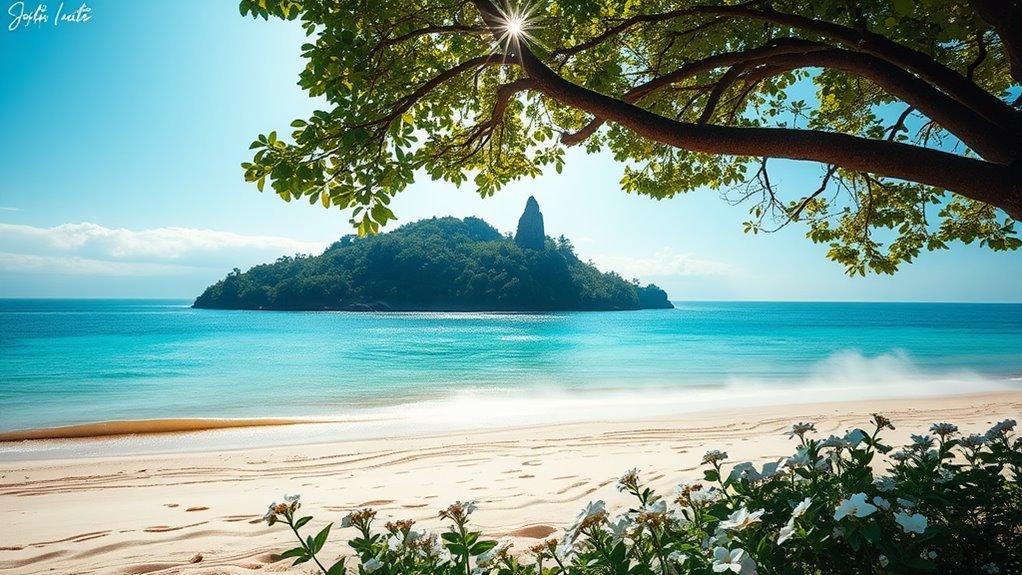Spiritual Meanings of Islands: 13 Sacred Symbols
As we explore the spiritual meanings of islands, we find that these landforms offer us a unique lens through which to understand transformation, healing, and connection. They serve as sacred retreats, embodying symbols that resonate deeply within various cultures. By examining the role of islands in mythology and their significance in our personal journeys, we can uncover layers of meaning that might surprise us. What do these sacred spaces really signify for our own lives, and how might they inspire our spiritual growth? Let's uncover these insights together.
Key Takeaways
- Islands symbolize tranquility and serve as retreats for healing and self-discovery, fostering mindfulness and gratitude.
- They represent resilience and renewal, emerging from the ocean as metaphors for personal transformation and rebirth.
- Islands reflect cultural heritage, containing stories and traditions that create a sense of belonging among communities.
- Viewed as sacred spaces, they connect people with ancestral spirits and emphasize the importance of coastal spirituality.
- Literary representations of islands explore themes of identity and connection, illustrating the shared human experience and personal redemption.
Islands as Sacred Retreats
Islands often serve as sacred retreats, places where we can escape the chaos of everyday life and reconnect with our inner selves. When we think of island meditation, it evokes a sense of tranquility that's hard to find elsewhere. The gentle sound of waves lapping against the shore, the warm sun kissing our skin, and the crisp air filled with the scent of salt and blooming flora all envelop us in a cocoon of peace.
During our spiritual retreats, we discover that these isolated havens offer more than just physical distance from our daily struggles; they provide a unique space for introspection and healing. Each moment spent on an island feels like a step toward uncovering layers of our true selves.
As we gather in these serene surroundings, we often find a shared sense of belonging, a connection to others who seek the same refuge. The sacredness of these islands nurtures our collective journey, reminding us that we're not alone in our search for meaning.
Through island meditation, we cultivate mindfulness and gratitude, allowing the stillness around us to resonate within, fostering a deeper connection to ourselves and the world.
Symbols of Transformation
Embracing the transformative power of islands, we often find ourselves surrounded by symbols that reflect our inner journeys. Each island can represent a metaphorical rebirth, a canvas where we can paint the stories of our lives anew. As we step onto the shores, we're not just visiting a physical space; we're entering a domain where transformative experiences unfold.
Consider the way islands emerge from the depths of the ocean, a proof of resilience and renewal. They remind us that, like them, we can rise from our struggles, reclaiming our identities in the process. The isolation of an island encourages introspection, urging us to confront our past, understand our present, and carve out a clearer future.
Nature's beauty, from the lush greenery to the serene waters, serves as a backdrop for our transformations. Each wave that kisses the shore can symbolize the shedding of old layers, while every sunrise invites us to embrace new beginnings.
Together, we can appreciate how these symbols resonate within us, guiding our paths toward self-discovery and growth. In this shared journey, we find connection, purpose, and a profound sense of belonging.
Places of Healing
As we venture to these secluded havens, we often discover that islands serve as profound places of healing, where the gentle rhythm of the sea and the whispering breeze invite us to release our burdens.
These tranquil sanctuaries provide a refuge from the chaos of daily life, allowing us to reconnect with ourselves and the natural world around us. The healing waters that surround these islands aren't just physical; they symbolize the flow of emotions and energy, washing away our worries and fears.
When we immerse ourselves in these serene environments, we can feel the weight of our struggles begin to lift. The vibrant flora and fauna remind us of life's resilience and beauty, encouraging us to embrace our own journey toward wholeness.
We often find solace in shared experiences with fellow seekers, creating bonds that deepen our sense of belonging.
In these moments, we realize that healing isn't a solitary path but a collective journey. The islands beckon us to listen, reflect, and ultimately, to heal together, reminding us that we're never truly alone in our quest for peace and restoration.
Islands in Mythology
Throughout history, tales of mythical islands have captivated our imaginations, offering glimpses into worlds beyond our own. These enchanting domains, often shrouded in mystery, invite us to explore the depths of our desires and fears. Islands like Avalon and Atlantis aren't just places on a map; they symbolize our longing for connection with the divine.
We can't help but be drawn to the idea of islands inhabited by mythical creatures, where mermaids sing their haunting melodies and dragons soar through the skies. These islands serve as gateways to divine domains, where the ordinary meets the extraordinary, transforming our understanding of reality. They remind us that there's more to life than what we see, urging us to seek deeper truths.
In these stories, we find not only adventure but also a sense of belonging. The inhabitants of these islands reflect our own struggles and triumphs, offering solace in their shared experiences.
As we immerse ourselves in these myths, we discover that these islands represent our collective yearning for a place where we can embrace our true selves, free from the confines of the mundane world.
Spiritual Journeys and Pilgrimages
Many of us commence spiritual journeys and pilgrimages seeking deeper meaning in our lives. These sacred travels often lead us to islands, where the isolation of land surrounded by water magnifies our intentions. As we explore these mystical places, we engage in spiritual exploration, uncovering layers of ourselves that may remain hidden in our daily routines.
Each step we take on these paths becomes a transformative experience, reshaping our perspectives and deepening our connections with the universe. We find ourselves reflecting on our purpose and the essence of our existence, often in harmony with nature's rhythms. The act of pilgrimage binds us to others who share our quest, creating a sense of belonging that transcends borders.
Islands, with their unique energies and histories, serve as powerful symbols of our collective journeys. They invite us to embrace vulnerability and open our hearts to new insights.
In this shared pursuit, we discover that each journey, while personal, contributes to a greater tapestry of spiritual awakening. Together, we honor the sacredness of our experiences, nurturing a community that celebrates the beauty of seeking and the wisdom we gain along the way.
Isolation and Introspection
Islands often offer a sanctuary for those seeking solitude, where the vast expanse of water creates a natural barrier from the distractions of everyday life. In this isolated space, we find the perfect environment for deep reflection. The gentle lapping of waves against the shore invites us to pause, to breathe, and to explore our thoughts.
As we sit in this serene setting, we can confront our inner landscapes, untangling the knots of our emotions. When we embrace solitude, we reveal the potential for personal growth. It's during these moments of quiet introspection that we can truly assess our lives, values, and aspirations.
The absence of external noise allows us to hear our own voices more clearly, guiding us toward the truths we often overlook in the hustle and bustle of everyday life. In this space, we not only reflect on our past experiences but also dream of our future selves.
Islands, with their remote beauty, remind us that solitude isn't loneliness; it's an opportunity. We can emerge from these experiences renewed, armed with insights that propel us forward on our journeys of personal growth.
Connection to Nature
When we step onto an island, we instantly tap into a profound connection to nature that's often lost in our fast-paced lives. Surrounded by the gentle lapping of waves and the rustling of leaves, we find ourselves enveloped in nature's embrace.
Here, we can reflect on how interwoven our existence is with the world around us, reminding us of the delicate ecological balance that sustains all life.
To deepen this connection, we can:
- Engage our senses: Let's listen to the symphony of birds, feel the cool breeze, and breathe in the salty air. Each sensation grounds us in the present.
- Observe wildlife: By watching the intricate behaviors of animals, we recognize the shared rhythms of life, awakening a sense of belonging to a larger ecosystem.
- Reflect on natural cycles: The changing tides and seasons remind us that we're part of an ongoing journey, encouraging us to embrace transformation.
In these moments, we realize that an island isn't just a physical space; it's a sanctuary that nurtures our connection to nature and reignites our sense of purpose in the world.
Cultural Significance of Islands
Stepping onto an island often reveals not just nature's beauty but also a rich tapestry of cultural significance woven into its very being. Each island tells a story, a narrative shaped by the unique cultural heritage of its inhabitants.
We find ourselves drawn to the island traditions that persist through generations, reflecting the values and beliefs of those who call these places home. As we explore these islands, we discover how their landscapes influence artistic expression, music, and dance.
Local festivals celebrate ancestral customs, allowing us to witness vibrant traditions that connect us to a collective history. This cultural richness fosters a sense of belonging, as we recognize that we're part of something greater than ourselves.
Moreover, islands often serve as sanctuaries of diversity, where different cultures intersect and intermingle. This fusion creates a dynamic environment, inviting us to learn from one another.
We gain insight into the resilience of communities, as they adapt their traditions in the face of change while remaining rooted in their cultural heritage.
In essence, islands aren't just geographical entities; they're living representations of humanity's shared journey, inviting us to appreciate our interconnectedness through the lens of cultural significance.
Islands in Indigenous Beliefs
Throughout history, many indigenous cultures have viewed islands as sacred spaces, imbued with spiritual significance that transcends their physical presence. For these communities, islands often symbolize a deeper connection to their beliefs and the natural world, forming an essential part of their indigenous cosmology.
We can explore this relationship through three key aspects:
- Mythical Origins: Many narratives speak of islands as the birthplace of creation, representing the unity of land, sea, and spirit.
- Sacred Geography: Islands are often seen as portals to the spiritual domain, where ancestors reside and guide the living.
- Cultural Identity: For countless indigenous peoples, islands serve as a touchstone for cultural identity, embodying their history and collective memory.
As we reflect on these themes, we recognize how islands provide not just a physical refuge but also a profound sense of belonging.
They're spaces where community and spirituality intertwine, reminding us of our shared connection to the land and the cosmos.
Embracing this understanding can deepen our appreciation for the sacred geography that shapes indigenous beliefs and practices.
Coastal Spirituality
Coastal spirituality, nestled between land and sea, invites us to explore the profound connections we share with these dynamic environments. When we stand on the shore, the rhythmic waves whisper ancient truths, reminding us of our place within the greater tapestry of life.
These coastal landscapes become sacred spaces where we can engage in coastal meditation, allowing the gentle sound of the ocean to guide our thoughts inward. As we breathe in the salty air, we can feel a sense of belonging, rooted in the earth yet ever-evolving like the tides.
Oceanic rituals, whether intentional or spontaneous, serve as a bridge to our inner selves and to one another. Lighting a candle at water's edge or offering a shell back to the sea can transform mere moments into profound expressions of gratitude and connection.
In these shared experiences, we cultivate a deeper understanding of our existence, embracing the ebb and flow of emotions mirrored in the ocean. By immersing ourselves in coastal spirituality, we foster not only personal growth but also a collective sense of unity with the natural world, reminding us that we're all part of something greater.
Representations of Freedom
Islands often symbolize freedom, standing as beacons of escape and individuality amid vast oceans. They evoke a sense of island liberation, inviting us to explore what it means to be free from the constraints of the mainland. When we think of these freedom symbols, we can reflect on the transformative power they hold in our lives.
Here are three ways islands represent freedom:
- Isolation and Reflection: The separation from the mainland provides a space for introspection, allowing us to confront our innermost thoughts away from societal expectations.
- Natural Beauty: The tranquil landscapes of islands inspire us to appreciate the beauty of simplicity, reminding us that freedom often lies in the unadorned moments of life.
Islands in Literature
The allure of islands extends beyond their physical beauty and symbolism of freedom; they also captivate our imaginations in literature. When we explore literary landscapes, we encounter islands as essential settings that embody isolation, discovery, and transformation.
Think of Shakespeare's "The Tempest," where the island becomes a crucible for personal redemption and confrontation. Here, island symbolism reveals our deepest fears and desires, inviting us to explore the dual nature of solitude—both as a refuge and a prison.
As we wander through these pages, we find ourselves reflecting on our own journeys. Islands challenge us to confront our inner selves, engaging with themes of identity and belonging. In works like "Lord of the Flies," the island serves as a microcosm for society, exposing the complexities of human nature.
These narratives remind us that islands aren't merely geographical formations; they're rich tapestries woven from our collective experiences. They invite us to join in the exploration of what it means to be human, urging us to seek connection and understanding in our own lives, even when we feel isolated.
Through their stories, we find a sense of belonging in the shared human experience.
Meditation and Mindfulness Spaces
A serene atmosphere often envelops meditation and mindfulness spaces, inviting us to pause and reflect.
These tranquil spaces allow us to reconnect with ourselves and foster a sense of belonging. When we engage in mindful breathing, we create a rhythm that calms our minds and opens our hearts. Together, we can explore how these sacred areas nurture our spirits.
Here are three essential elements of effective meditation spaces:
- Natural Elements: Surrounding ourselves with plants, water, and stones can ground us, enhancing our connection to nature.
- Soft Lighting: Gentle, warm light fosters a calming ambiance, encouraging us to let go of distractions and embrace the moment.
- Comfortable Seating: Creating a cozy spot with cushions or mats allows us to settle in, promoting relaxation and focus.
As we cultivate these tranquil spaces, we deepen our practice of mindfulness. Each breath becomes a reminder of our shared journey, a gentle nudge to be present.
In these moments, we find solace, healing, and a profound sense of community. Let's cherish the beauty of our collective exploration in these sacred sanctuaries.
Frequently Asked Questions
What Are the Most Famous Islands With Spiritual Significance?
When we explore islands with spiritual significance, we discover sacred landscapes like Bali and Santorini, each offering serene spiritual retreats. These places invite us to connect, reflect, and find a deeper sense of belonging.
How Do Different Cultures View Islands Spiritually?
We've noticed that different cultures weave island mythology into their narratives, creating sacred landscapes that resonate deeply. These islands become sanctuaries, reflecting our collective longing for connection, peace, and a sense of belonging in a vast world.
Can Visiting an Island Enhance Spiritual Experiences?
Visiting an island can truly enhance our spiritual experiences. We find that island meditations and sacred retreats allow us to connect deeply with nature, fostering a sense of belonging and tranquility that enriches our inner journeys.
Are There Rituals Associated With Island Spirituality?
When we explore island spirituality, we discover rich island rituals and sacred ceremonies that connect us to the land and each other. These practices invite us to reflect, heal, and embrace a sense of belonging together.
How Do Islands Symbolize Solitude in Spiritual Practices?
Islands symbolize solitude in our spiritual practices, offering tranquil spaces for island meditation. These sacred retreats help us connect deeply with ourselves, fostering reflection and a sense of belonging as we embrace nature's peaceful embrace.

I’m Eliza Trinity, a spiritual guide and writer at SoulfulSignificance.com, where my mission is to illuminate the path of spiritual fulfillment through Christ’s teachings. With a Theology degree and a counseling background, I blend biblical wisdom with real-world insight to support those on their journey to discovering their soul’s significance.





